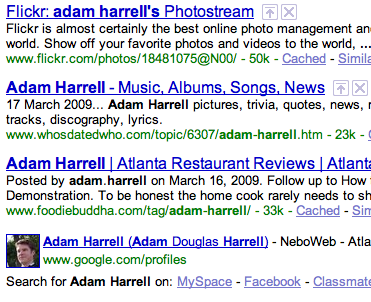The 411 on 404 Pages
Recently on Twitter Lisa Barone pointed out that the 404 page she setup drives some of her colleagues at Outspoken Media crazy. Personally I think it's hysterical, but that's not the point. Lisa got me thinking about the point of a 404 error page and what makes one good.
The great thing about 404 pages is that you essentially have a whole page dedicated to one very short message. This means you don't need to sacrifice creativity for utility. The 404 page is one of the easiest places to create a user experience that is both memorable and useful. As I scoured the internet for quality 404 pages I was quite disappointed that many social media experts, marketers, and even some well known agencies have bland or unhelpful 404 pages. So, without further ado, I give you ten prime examples of a quality 404 error page:
How do you measure the value of design?
It's a fair question that deserves to be addressed. How should a company measure the value of design? What is the contribution that design makes to the bottom line?
This is a difficult problem. Sure there are numerous anecdotes that provide evidence that a focus on design leads to success (Apple, Google, Facebook etc). But, anytime you're attempting to isolate and measure a single variable in a complex environment it will be difficult.
A few years ago the British Council of Design commissioned a study that does provide some quantitative evidence. They created a stock index tracking the 61 firms that had won major awards in british design contests. This index fund outperformed its peers by over 200% during the study. This may not prove a causal link, but perhaps it proves at least a correlation between design and performance.
The Shift Towards One Identity
The web has always been a place of multiple identities. Right now I act differently on my personal blog, this blog, Twitter, Facebook, and LinkedIn. I have multiple identities. In the future there will only be one identity.
The best user experiences are invisible
The most seamless user experiences are often the least noticeable. They just work. You google something and it returns the right results. It's a variation of Clarke's 3rd law, instead of "Any sufficiently advanced technology is indistinguishable from magic", it is: "Any sufficiently advanced user experience is invisible to the user."
This is the reason that projects include user personas and audience goals. The core objective of a website should be to allow users to accomplish the tasks they set out to accomplish in the most efficient way possible. Whether people are visiting to purchase, to request more information or to be entertained. A good user experience shouldn't get in the way of the user's tasks.
Now, there are times that you want the experience to be notable. That you want to communicate a little bit extra in your user interactions. In these cases an interface is designed to draw attention to itself. But, at these times the core experience still needs to be as seamless as possible. If you were to strip away the extras (the humorous responses etc) the core experience should be as close to invisible as possible.
So next time your deciding on whether to run unaffiliated network ads on your website, or whether to require a form before downloading a white paper—think to yourself, does this help or hinder my user's experience. Am I interrupting them on their tasks? Is there anyway to make this a more elegant process?
Surviving Short Term Success with Endurance
- I was checking out some pictures on Todd Huffman's Flickr account and saw he wrote something very quotable beneath one of his pictures. (Todd works with the FabLab for technology in Afghanistan)
Afghans are not impressed with might, but they do respect endurance.
In light of the current economic crisis it has become increasingly clear that size is not equivalent with success. What you do today effects the brand tomorrow. While size does not imply a successful strategy, cutting spending now may not be a good idea.
Quick thoughts on Google Profiles.
Unless you've been hiding under a rock today, you've probably heard about Google Profiles. In case you haven't, these are essentially simple profile pages that will show up in search results when some googles you.
As you'd expect from google, the setup process is super simple. Fill out a couple highlights, import your photos from flickr/picasa, add a couple links and you're done.
What I'm not so wild about is the implementation into the search results. The design approach seems lazy. They're just putting the profiles at the bottom of the first page and making the type slightly smaller. If you want it to just blend in with the results, then why even bother making the type smaller. And honestly, no one really wants to be on the bottom of the first page for their own name. Google being Google however, I'm sure that they're currently testing numerous iterations and will end up going with whatever version the data tells them is most effective.
That being said, it was only a matter of time before they took this step. So go grab your profile before someone else with your name steals it.
